Measurement of Sulfur-Dioxide Emissions from Ocean-Going Vessels in Belgium Using Novel Techniques
Abstract
:1. Introduction
1.1. Belgian Sniffer Program
1.2. Interactions from Other OGV Emissions
1.3. Research Area and Time Frame
2. Methods and Materials
2.1. Airborne Platform and Sniffer Sensor
2.2. NOx Sensor
2.3. Hydrocarbon Kicker
2.4. Updated Sniffer Sensor Software and Sulfur Emissions Measurements
2.4.1. NO Cross Sensitivity
2.4.2. NO Assessment
2.4.3. FSC Correction
2.5. Sniffer Quality Management System
2.6. Statistical Analysis
3. Results and Discussion
3.1. Monitoring Results
3.2. NO Interference
3.3. NO/NOx in Stack Ratio (ISR)
3.4. Hydrocarbon Kicker
3.5. Improvement of Measurement Quality and Reduced Uncertainty
3.5.1. Improvement of Response Time
3.5.2. Improved Signal-to-Noise Ratio (SNR)
3.5.3. Reduced Uncertainty
3.6. Measurement Results
3.6.1. FSC Correction
3.6.2. Average FSC
3.7. OGV Compliance Analysis
3.7.1. Lowered Compliance Thresholds
3.7.2. Evaluation of Non-Compliance
3.7.3. Compliance Rate Comparison
3.7.4. Global Sulfur Cap and Global Bunker Fuel Prices
3.7.5. Compliance of OGVs with a Scrubber Installation
3.7.6. Geospatial Analysis
4. Conclusions
Supplementary Materials
Author Contributions
Funding
Institutional Review Board Statement
Informed Consent Statement
Data Availability Statement
Acknowledgments
Conflicts of Interest
References
- IMO. MARPOL Convention for the Prevention of Pollution from Ships of 1978; IMO: London, UK, 1978. [Google Scholar]
- MEPC. Amendments to the Annex of the Protocol of 1997 to Amend the International Convention for the Prevention of Pollution from Ships, 1973, as Modified by the Protocol of 1978 Relating Thereto (Revised MARPOL Annex VI); Marine Environment Protection Committee: London, UK, 2008; pp. 1–46. [Google Scholar]
- EU (The European Parliament and the Council of the European Union). Directive (EU) 2016/802 of the European Parliament and of the Council of 11 May 2016 relating to a reduction in the sulphur content of certain liquid fuels. Off. J. Eur. Union L 2016, 132, 58–78. [Google Scholar]
- Royal Decree. Wet Tot Invoering Van Het Belgisch Scheepvaartwetboek. Belgisch Staatsblad, 8 May 2019; 75432–75808. [Google Scholar]
- Van Roy, W.; Schallier, R.; Van Roozendael, B.; Scheldeman, K.; Van Nieuwenhove, A.; Maes, F. Airborne monitoring of compliance to sulfur emission regulations by ocean-going vessels in the Belgian North Sea area. Atmos. Pollut. Res. 2022, 13, 101445. [Google Scholar] [CrossRef]
- Van Roy, W.; Scheldeman, K. Compliance monitoring pilot for MARPOL Annex VI, Best Practices Airborne MARPOL Annex VI Monitoring; Royal Belgian Institute of Natural Sciences: Brussels, Belgium, 2016; Available online: https://ec.europa.eu/inea/en/connecting-europe-facility/cef-transport/projects-by-country/multi-country/2014-eu-tm-0546-s (accessed on 7 September 2022).
- Van Roy, W.; Scheldeman, K. Compliance monitoring pilot for MARPOL Annex VI, Results MARPOL Annex VI Monitoring Report Belgian Sniffer Campaign; Royal Belgian Institute of Natural Sciences: Brussels, Belgium, 2016; Available online: https://ec.europa.eu/inea/en/connecting-europe-facility/cef-transport/projects-by-country/multi-country/2014-eu-tm-0546-s (accessed on 7 September 2022).
- EU (The European Commission). Commission Implementing Decision (EU) 2015/253-of 16 February 2015-laying down the rules concerning the sampling and reporting under Council Directive 1999/32/EC as regards the sulphur content of marine fuels. Off. J. Eur. Union L 2015, 41, 45–59. [Google Scholar]
- Explicit ApS. Airborne Monitoring of Sulphur Emissions from Ships in Danish Waters, 2019 Campaign Results; The Danish Environmental Protection Agency: Odense, Denmark, 2020; Available online: http://www.c9h.dk/gfx/pdf/978-87-7038-157-4.pdf (accessed on 7 September 2022).
- Explicit ApS. Airborne Monitoring of Sulphur Emissions from Ships in Danish Waters, 2018 Campaign Results; The Danish Environmental Protection Agency: Odense, Denmark, 2019; Available online: https://www2.mst.dk/Udgiv/publications/2019/01/978-87-7038-023-2.pdf (accessed on 7 September 2022).
- Mellqvist, J.; Conde, V. Surveillance of Sulfur Fuel Content in Ships at the Great Belt Bridge 2018; The Danish Environmental Protection Agency: Odense, Denmark, 2019; Available online: https://www2.mst.dk/Udgiv/publikationer/2019/10/978-87-7038-123-9.pdf (accessed on 7 September 2022).
- Mellqvist, J.; Conde, V. Surveillance of Sulfur Fuel Content in Ships at the Great Belt Bridge 2019; The Danish Environmental Protection Agency: Odense, Denmark, 2020; Available online: https://mst.dk/service/publikationer/publikationsarkiv/2020/jul/surveillance-of-sulfur-fuel-content-in-ships-at-the-great-belt-bridge-2019/ (accessed on 7 September 2022).
- MEPC. Guidelines for Exhaust Gas Cleaning Systems; Marine Environment Protection Committee: London, UK, 2009; pp. 1–26. [Google Scholar]
- MEPC. 2015 Guidelines for Exhaust Gas Cleaning Systems; Marine Environment Protection Committee: London, UK, 2015; pp. 1–23. [Google Scholar]
- Endres, S.; Maes, F.; Hopkins, F.; Houghton, K.; Mårtensson, E.M.; Oeffner, J.; Quack, B.; Singh, P.; Turner, D. A new perspective at the ship-air-sea-interface: The environmental impacts of exhaust gas scrubber discharge. Front. Mar. Sci. 2018, 5, 139. [Google Scholar] [CrossRef] [Green Version]
- Dulière, V.; Baetens, K.; Lacroix, G. Potential Impact of Wash Water Effluents from Scrubbers on Water Acidification in the Southern North Sea; Royal Belgian Institute of Natural Sciences: Brussels, Belgium, 2018; Available online: http://www.naturalsciences.be (accessed on 7 September 2022).
- Winnes. Scrubbers: Closing the loop-Activity 3: SummaryEnvironmental analysis of marine exhaust gas scrubbers on two Stena Line ships; Swedish Environment Research Institute (IVL): Stockholm, Sweden, 2018; Available online: https://www.ivl.se/download/18.694ca0617a1de98f47296f/1628413620960/FULLTEXT01.pdf (accessed on 7 September 2022).
- Teuchies, J.; Cox, T.J.S.; van Itterbeeck, K.; Meysman, F.J.R.; Blust, R. The impact of scrubber discharge on the water quality in estuaries and ports. Environ. Sci. Eur. 2020, 32, 1–11. [Google Scholar] [CrossRef]
- Marin-Enriquez, O.; Krutwa, A.; Ewert, K. Environmental Impacts of Exhaust Gas Cleaning Systems for Reduction of SOx on Ships-Analysis of status quo. In Report complied within the framework of the project ImpEx; German Environment Agency: Dessau-Roßlau, Germany, 2021; Available online: https://www.umweltbundesamt.de/sites/default/files/medien/5750/publikationen/2021-05-28_texte_83-2021_sox-ships.pdf (accessed on 7 September 2022).
- Hassellov, I.-M.; Hermansson, A.L.; Ytreberg, E. Current Knowledge on Impact on the Marine Environment of Large-Scale Use of Exhaust Gas Cleaning Systems (scrubbers) in Swedish Waters–Technical Report; Chalmers University of Technology: Gothenburg, Sweden, 2020; Available online: www.chalmers.se (accessed on 7 September 2022).
- Ship and Bunker. Scrubber Equipped Tonnage Now 30% of Boxship Capacity. Available online: https://shipandbunker.com/news/world/867193-scrubber-equipped-tonnage-now-30-of-boxship-capacity (accessed on 7 September 2022).
- Corbett, J.J.; Fischbeck, P.S. Emissions from Ships. Science 1997, 278, 823–824. [Google Scholar] [CrossRef]
- IMO. Third IMO GHG Study 2014 Executive Summary and Final Report. Available online: www.imo.org (accessed on 7 September 2022).
- Heywood, J. Internal Combustion Engine Fundamentals, 2nd ed.; McGraw-Hill Education Ltd.: New York, NJ, USA, 2018. [Google Scholar]
- Beecken, J.; Mellqvist, J.; Salo, K.; Ekholm, J.; Jalkanen, J.P. Airborne emission measurements of SO2, NOx and particles from individual ships using a sniffer technique. Atmos. Meas. Tech. 2014, 7, 1957–1968. [Google Scholar] [CrossRef]
- Kattner, L.; Mathieu-Üffing, B.; Burrows, J.P.; Richter, A.; Schmolke, S.; Seyler, A.; Wittrock, F. Monitoring compliance with sulfur content regulations of shipping fuel by in situ measurements of ship emissions. Atmos. Chem. Phys. 2015, 15, 10087–10092. [Google Scholar] [CrossRef] [Green Version]
- Van Roy, W.; Scheldeman, K.; Van Roozendael, B.; Van Nieuwenhove, A.; Schallier, R.; Vigin, L.; Maes, F. Airborne monitoring of compliance to NOx emission regulations from ocean-going vessels in the Belgian North Sea area. Atmos. Pollut. Res. 2022, 13, 101518. [Google Scholar] [CrossRef]
- Maes, F.; Cliquet, A.; Van Gaever, S.; Lescrauwaet, A.-K.; Pirlet, H.; Verleye, T.; Mees, J.; Herman, R. Raakvlak Marien Onderzoek En Beleid. In Compendium Voor Kust En Zee 2013: Een Geïntegreerd kennisdocument over De Socio-Economische, Ecologische En Institutionele Aspecten Van De Kust En Zee in Vlaanderen En België; Vlaams Instituut voor de Zee (VLIZ): Oostende, Belgium, 2013; pp. 286–323. [Google Scholar]
- Cooper, D. Exhaust emissions from ships at berth. Atmos. Environ. 2003, 37, 3817–3830. [Google Scholar] [CrossRef]
- Royal Decree. Koninklijk besluit tot vaststelling van het Marien Ruimtelijk Plan voor de periode van 2020 tot 2026 in de Belgische zeegebieden. Belgisch Staatsblad, 22 May 2019; 1–52.
- Weigelt, A. Sulphur Emission Compliance Monitoring of Ships in German Waters–Results from Five Years of Operation. In Shipping and the Environment, Symposium on Scenarios and Policy Options for Sustainable Shipping (POL); BSH: Munich, Germany, 2019. [Google Scholar]
- Mellqvist, J.; Beecken, J.; Conde, V.; Ekholm, J. Surveillance of Sulfur Emissions from Ships in Danish Waters; Chalmers University of Technology: Göteborg, Sweden, 2017. [Google Scholar]
- Balzani Lööv, J.M.; Alfoldy, B.; Gast, L.F.L.; Hjorth, J.; Lagler, F.; Mellqvist, J.; Beecken, J.; Berg, N.; Duyzer, J.; Westrate, H.; et al. Field test of available methods to measure remotely SOx and NOx emissions from ships. Atmos. Meas. Tech. 2014, 7, 2597–2613. [Google Scholar] [CrossRef] [Green Version]
- Alföldy, B.; Lööv, J.B.; Lagler, F.; Mellqvist, J.; Berg, N.; Beecken, J.; Weststrate, H.; Duyzer, J.; Bencs, L.; Horemans, B.; et al. Measurements of air pollution emission factors for marine transportation in SECA. Atmos. Meas. Tech. 2013, 6, 1777–1791. [Google Scholar] [CrossRef]
- Devore, J.L.; Berk, K.N.; Carlton, M.A. Modern Mathematical Statistics with Applications; Springer: Berlin/Heidelberg, Germany, 2011. [Google Scholar]
- Gardner, M.J.; Altman, D.G. Estimating with confidence. BMJ 1988, 296, 1210. [Google Scholar] [CrossRef] [PubMed]
- Sprinthall, R.C. Basic Statistical Analysis, 9th ed.; Pearson: London, UK, 2011. [Google Scholar]
- Dinh, T.-V.; Choi, I.-Y.; Son, Y.-S.; Song, K.-Y.; Sunwoo, Y.; Kim, J.-C. Volatile organic compounds (VOCs) in surface coating materials: Their compositions and potential as an alternative fuel. J. Environ. Manag. 2016, 168, 157–164. [Google Scholar] [CrossRef] [PubMed]
- Royal Decree. Compendium voor de monsterneming, meting en analyse van water (WAC)-Meetonzekerheid (VITO). Belgisch Staatsblad, 23 January 2014.
- Notteboom, T. The impact of low sulphur fuel requirements in shipping on the competitiveness of roro shipping in Northern Europe. WMU J. Marit. Aff. 2011, 10, 63–95. [Google Scholar] [CrossRef]
- Notteboom, T.; Cariou, P. Fuel Surcharge Practices of Container Shipping Lines: Is it About Cost Recovery or Revenue Making? In Proceedings of the 2009 International Association of Maritime Economists (IAME) Conference, Copenhagen, Denmark, 24–26 June 2009. [Google Scholar]
- MEPC. Effective Date of Implementation of the Fuel Oil Standard in Regulation 14.1.3 of MARPOL Annex VI; Marine Environment Protection Committee: London, UK, 2016; pp. 1–3. [Google Scholar]
- MEPC. Amendments to the Annex of the Protocol of 1997 to Amend the International Convention for the Prevention of Pollution from Ships, 1973, as Modified by the Protocol of 1978 Relating Thereto; Marine Environment Protection Committee: London, UK, 2018; pp. 1–5. [Google Scholar]
- ABC. ABS Advisory on Exhaust Gas Scrubber Systems; ABC: Lorraine, France, 2018. [Google Scholar]
- Mussatti, D. Section 6, Particulate Matter Controls. In EPA Air Pollution Control Cost Manual; US Environmental Protection Agency: Colombia, WA, USA, 2002; pp. 1–62. [Google Scholar]
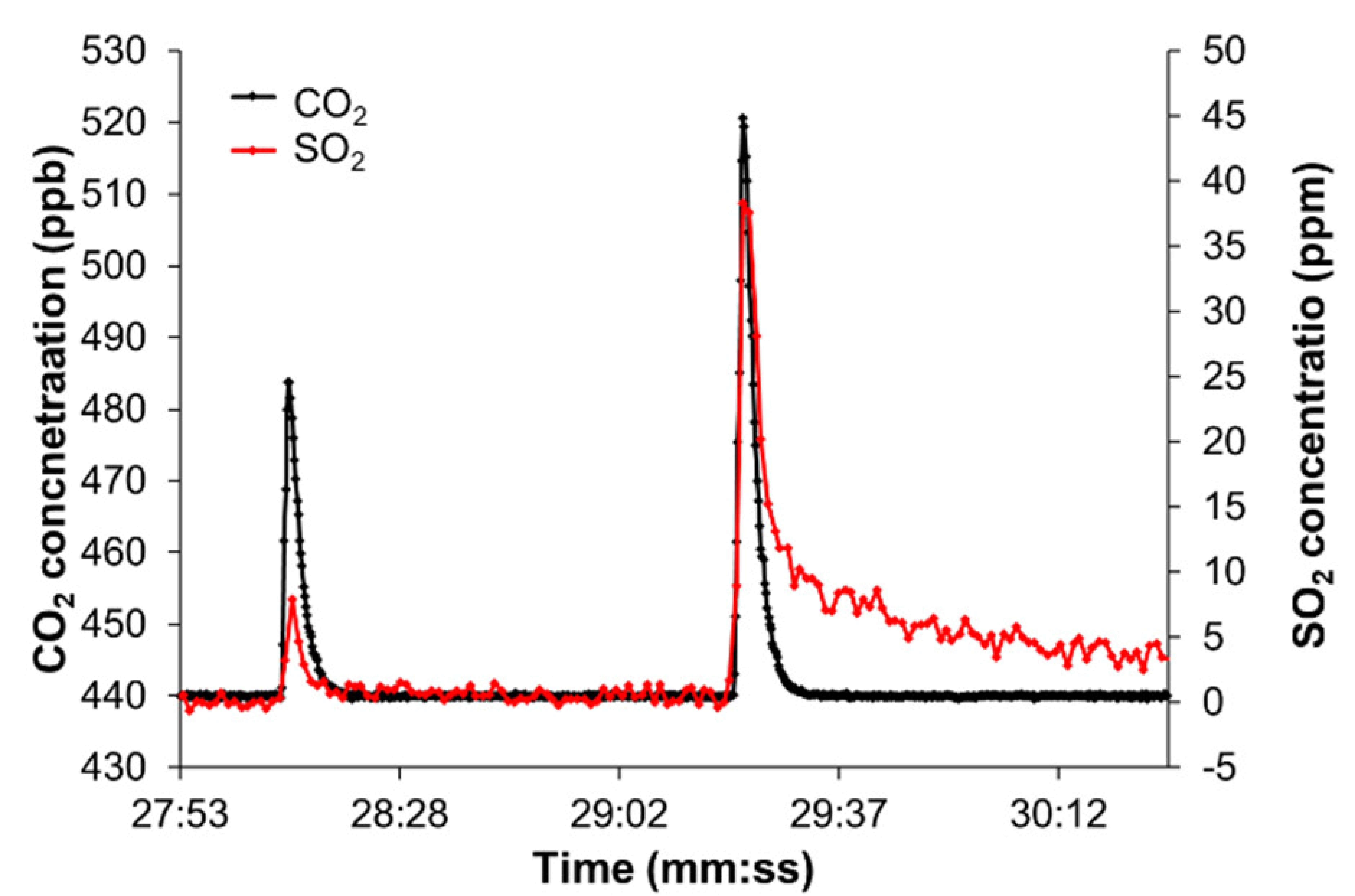

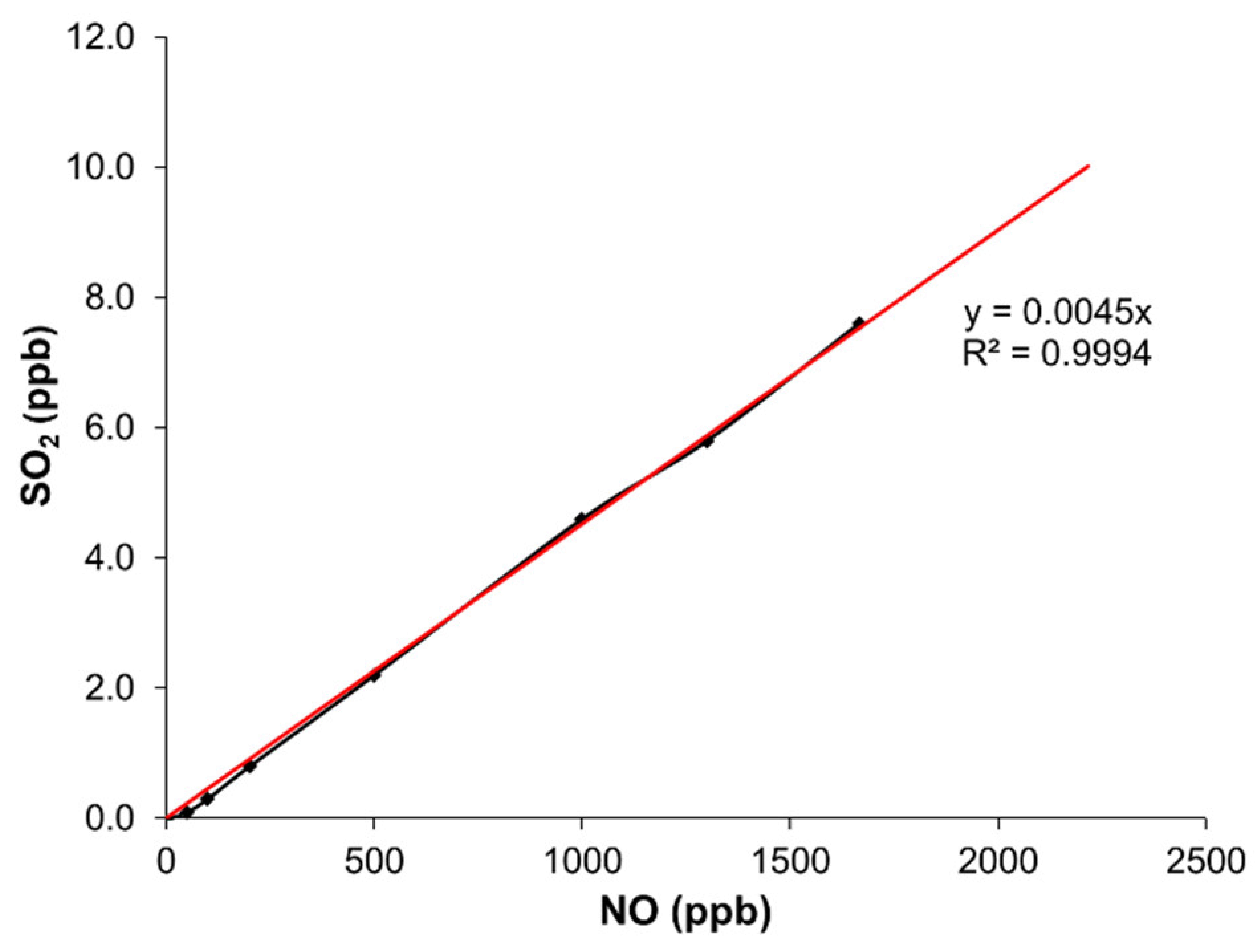
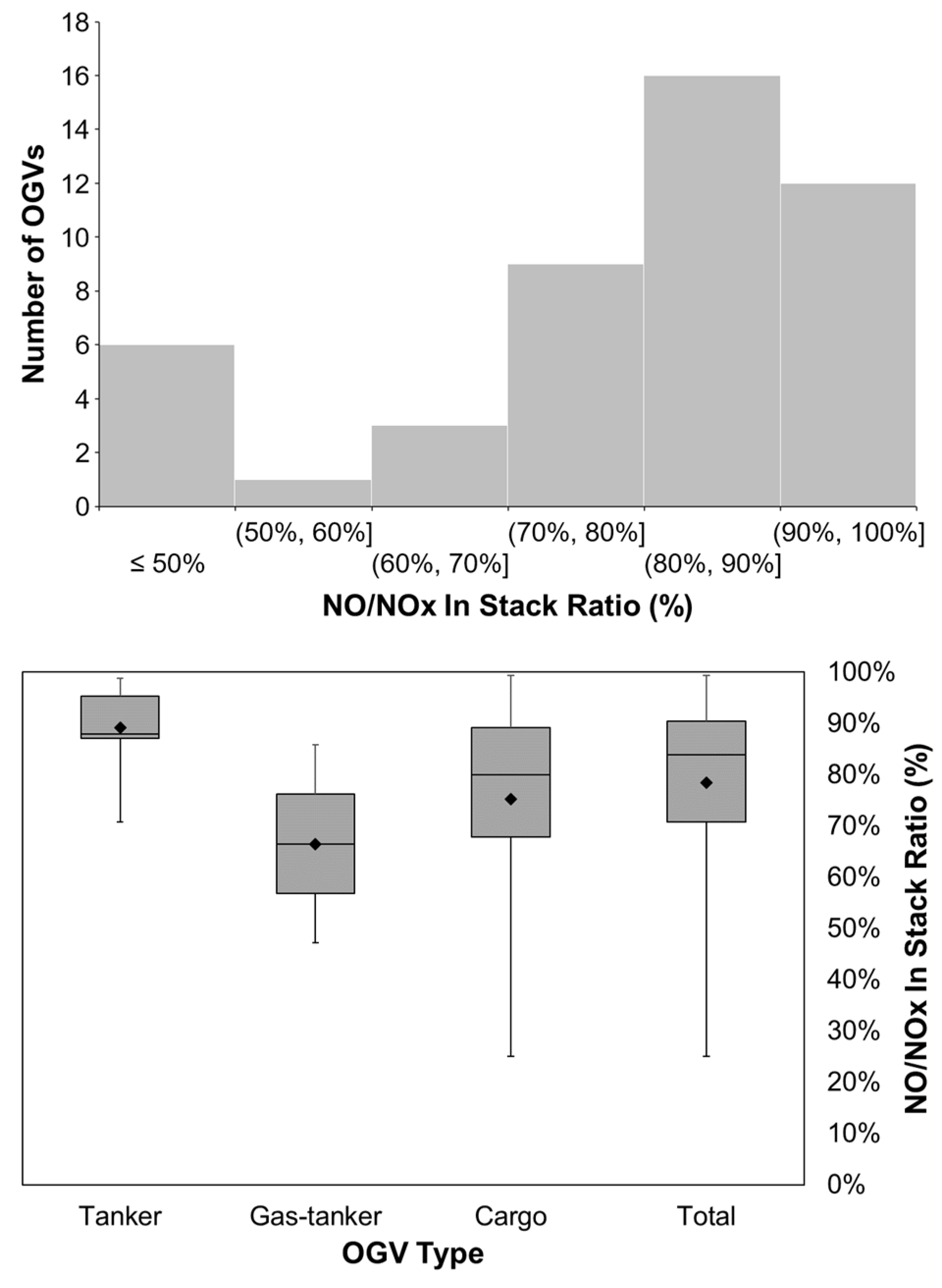



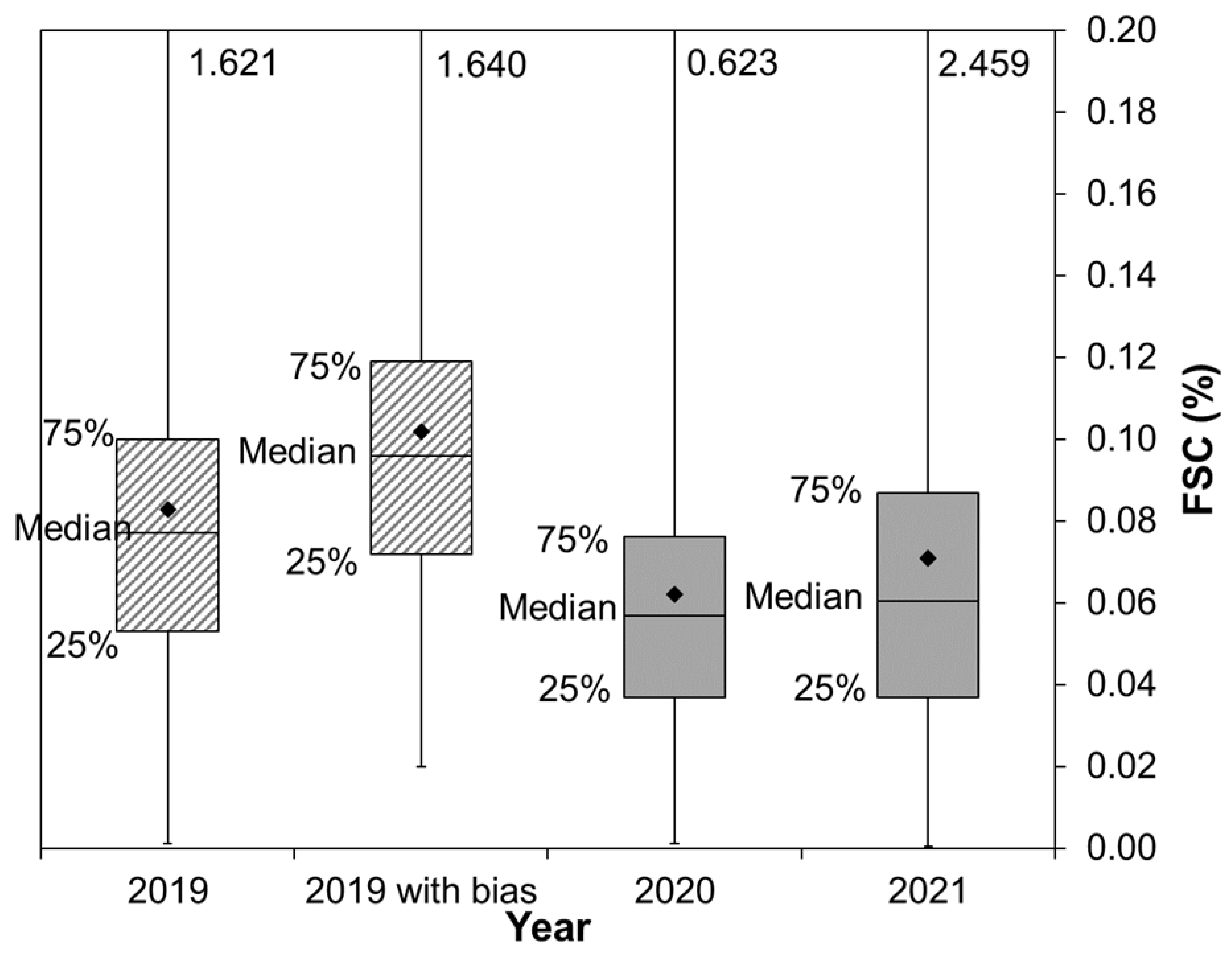
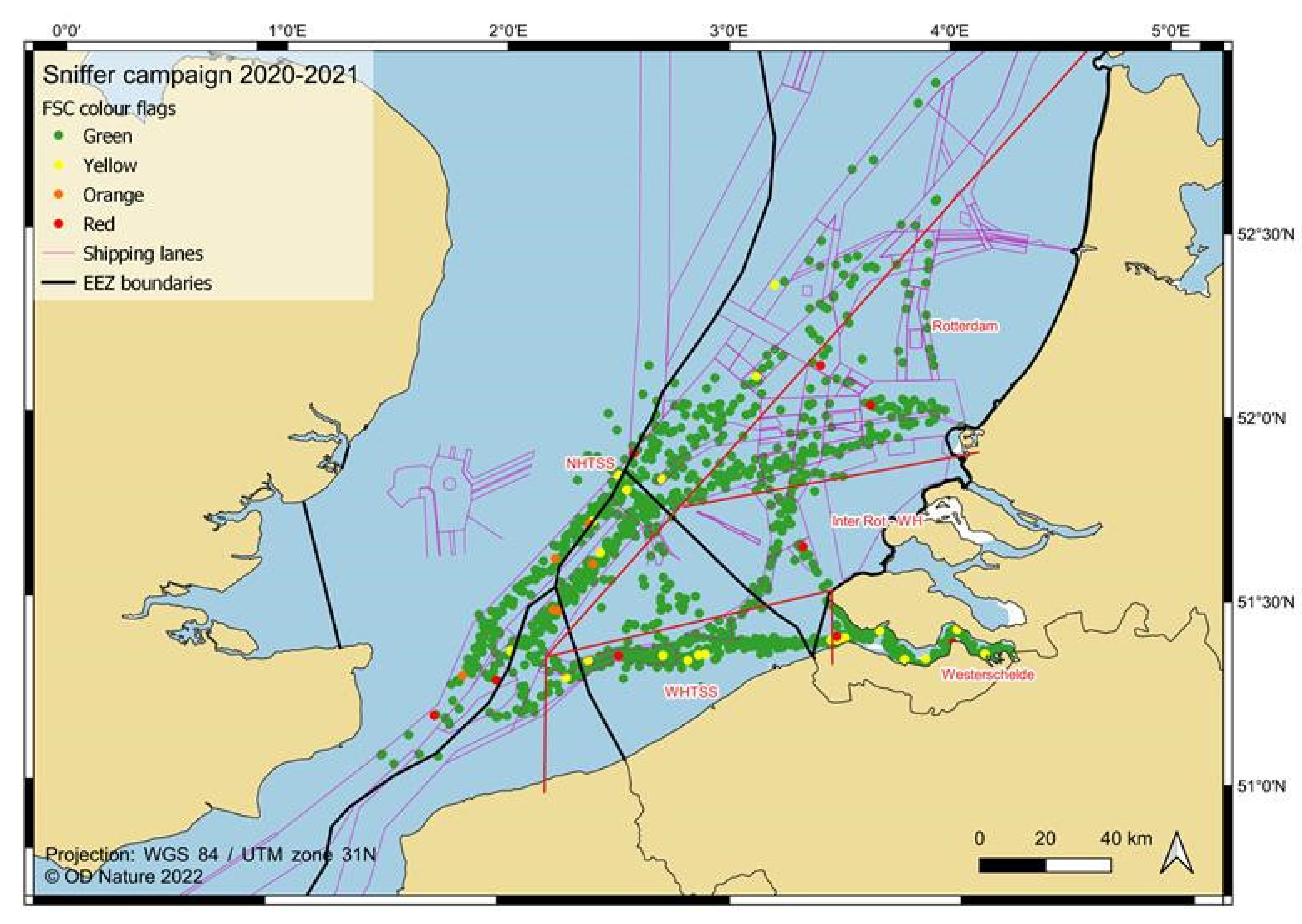


| FSC Range | 0.13–0.2% | 0.2–3% | >3% |
|---|---|---|---|
| CVRW | 18.0% | 8.04% | 4.82% |
| n | 20 | 12 | 14 |
| utot | 25% | 20% | 18% |
| |b| | 15% | 14% | 12% |
| t | 2.086 | 2.179 | 2.145 |
| U (95% CI) | 67% | 58% | 51% |
| Color Flag | t | U | CI | Sulfur Limit | T | TOPS |
|---|---|---|---|---|---|---|
| Yellow | 0.86 | 22% | 60% | 0.10% | 0.13% | 0.13% |
| Orange | 2.179 | 38% | 95% | 0.11% | 0.19% | 0.20% |
| Red | 2.528 | 48% | 99% | 0.15% | 0.28% | 0.30% |
| Color Flag | t | Un=2 | CI | Sulfur Limit | Tn=2 | TOPS_n=2 |
|---|---|---|---|---|---|---|
| Yellow | 0.86 | 15% | 60% | 0.10% | 0.12% | 0.12% |
| Orange | 2.179 | 30% | 95% | 0.11% | 0.16% | 0.16% |
| Red | 2.528 | 33% | 99% | 0.15% | 0.22% | 0.25% |
Publisher’s Note: MDPI stays neutral with regard to jurisdictional claims in published maps and institutional affiliations. |
© 2022 by the authors. Licensee MDPI, Basel, Switzerland. This article is an open access article distributed under the terms and conditions of the Creative Commons Attribution (CC BY) license (https://creativecommons.org/licenses/by/4.0/).
Share and Cite
Van Roy, W.; Van Nieuwenhove, A.; Scheldeman, K.; Van Roozendael, B.; Schallier, R.; Mellqvist, J.; Maes, F. Measurement of Sulfur-Dioxide Emissions from Ocean-Going Vessels in Belgium Using Novel Techniques. Atmosphere 2022, 13, 1756. https://doi.org/10.3390/atmos13111756
Van Roy W, Van Nieuwenhove A, Scheldeman K, Van Roozendael B, Schallier R, Mellqvist J, Maes F. Measurement of Sulfur-Dioxide Emissions from Ocean-Going Vessels in Belgium Using Novel Techniques. Atmosphere. 2022; 13(11):1756. https://doi.org/10.3390/atmos13111756
Chicago/Turabian StyleVan Roy, Ward, Annelore Van Nieuwenhove, Kobe Scheldeman, Benjamin Van Roozendael, Ronny Schallier, Johan Mellqvist, and Frank Maes. 2022. "Measurement of Sulfur-Dioxide Emissions from Ocean-Going Vessels in Belgium Using Novel Techniques" Atmosphere 13, no. 11: 1756. https://doi.org/10.3390/atmos13111756
APA StyleVan Roy, W., Van Nieuwenhove, A., Scheldeman, K., Van Roozendael, B., Schallier, R., Mellqvist, J., & Maes, F. (2022). Measurement of Sulfur-Dioxide Emissions from Ocean-Going Vessels in Belgium Using Novel Techniques. Atmosphere, 13(11), 1756. https://doi.org/10.3390/atmos13111756







